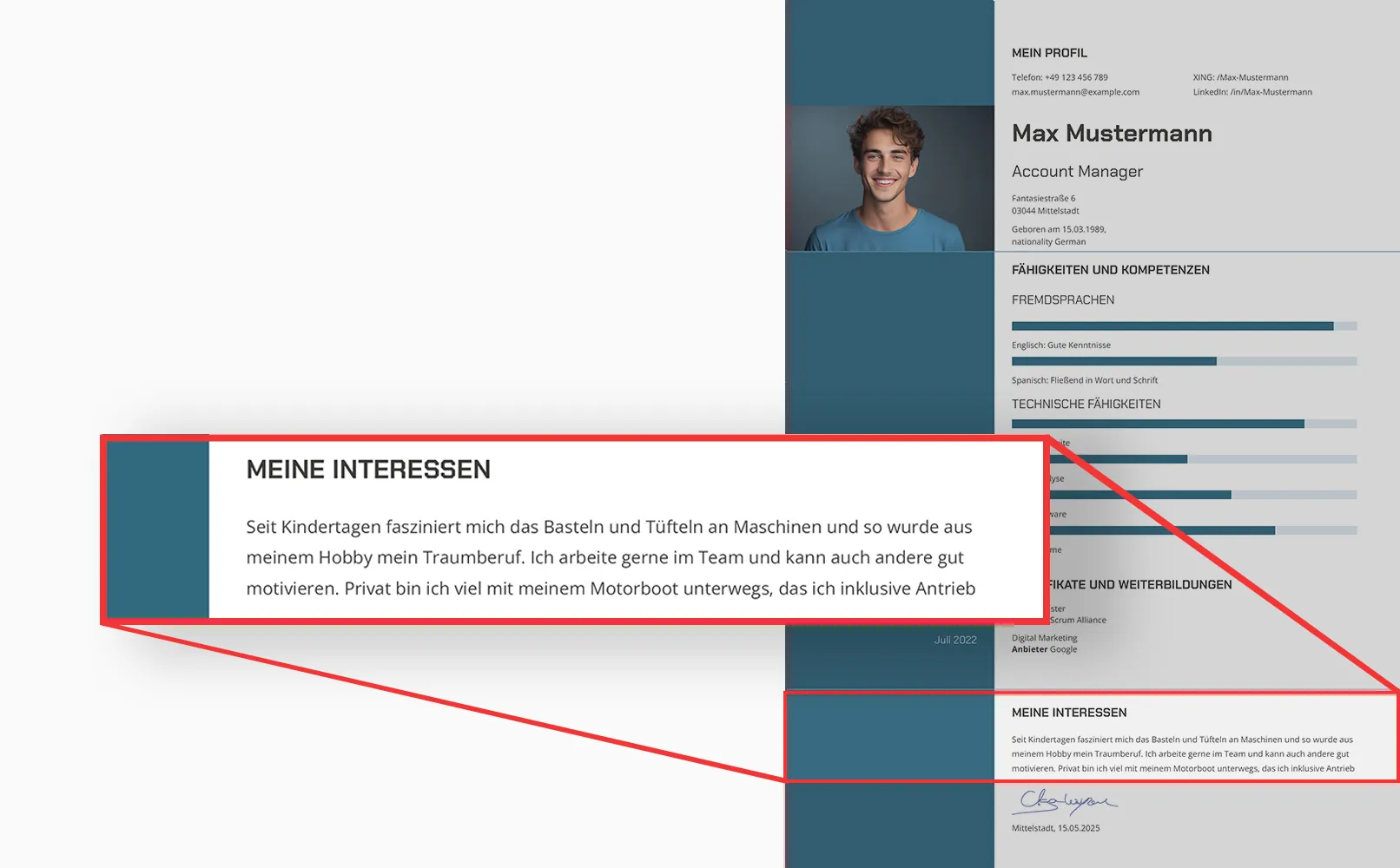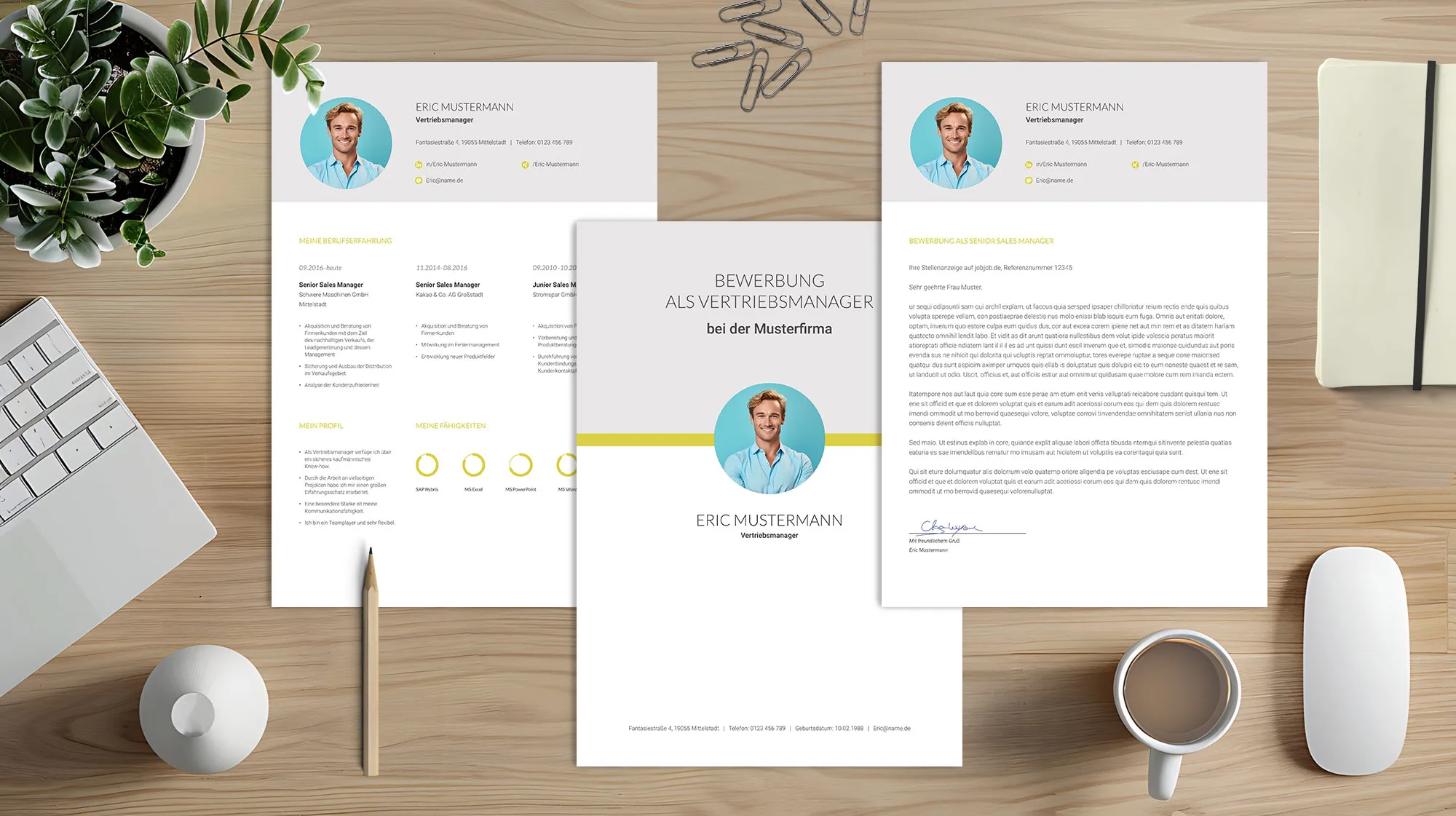Hobbies and interests in a resume: Tips and common mistakes
This article shows you which hobbies and interests to include in your resume, how to present them, and what mistakes to avoid. Handle this section responsibly, and it could be your trump card in the application process as it provides information about your cultural fit with the company.

This article on hobbies and interests in the resume is part of a comprehensive guide on structuring your resume. Here you will learn how to optimally design this often underestimated section to highlight your personality and additional skills. Do you want to learn more about the various aspects of a successful resume? Then visit the following link and discover our other articles on resume structuring.
The Role of Hobbies and Interests in the Resume
Do not underestimate the importance of the hobbies and interests section in your resume. It is not just an additional point or a formality but a real opportunity to show the employer who you are outside of work. It reveals your personal traits, showcases additional skills, and can be a decisive argument in the selection between candidates.
Trust takes a lifetime to build, but only a moment to destroy. When looking to build a genuine connection with a mentor, you can simply partake in shared hobbies or activities the mentee or mentor is into, exchange stories, or partake in trust-building workshops together.
Tobias Harris
By showcasing your hobbies, you make it clear to the employer that you are an active and versatile individual who can bring added value to the team and fit well into the company culture. Avoid clichés and only mention what truly highlights your uniqueness and professionalism.
What Information Should Be Included
Note that the hobbies and interests section is not the place for a thoughtless list. Each listed hobby should work for you and emphasize your value to the employer. Let's take a closer look at what should be included here.

Relevant Hobbies: Do not list everything. Consider only hobbies that are related to your professional skills or highlight important personal traits. For example, if you are a programmer, mention participation in hackathons or open-source projects.
Social Interests: Participation in volunteer projects or nonprofit organizations demonstrates your social activity and responsibility. This signals to the employer that you are interested in your community and willing to help others.
Individual Sports: There are sports that require a lot of discipline to succeed. If you do weight training or train for a triathlon or marathon, you show the employer that you can maintain your motivation over the long haul.
Team Sports: Engaging in team sports demonstrates your teamwork skills. Football, volleyball, basketball - all these sports showcase your ability to collaborate and achieve common goals, which is a plus for you as a candidate.
Creative Hobbies: Creative interests can underline your ability for unconventional thinking. Painting, music, writing - all these activities emphasize your creativity and talent for generating new ideas.
Self-Development: Reading professional literature, attending seminars, and training sessions show that you are constantly striving to develop yourself. This signals to the employer that you are willing to learn and improve your skills.
By including this information, you turn your hobbies and interests into additional advantages that highlight your value as a candidate. Therefore, do not fill this section with unnecessary details - each hobby should be an argument for you!

Why It's Necessary to Fill Out the Hobbies and Interests Section
Do not ignore the opportunity to talk about your hobbies and interests. This is your additional chance to influence the employer's opinion and offers the following benefits:
Impression of Personality: Knowledge about your hobbies and interests helps the employer understand who you are in your free time. They provide insight into your personality, values, and priorities and convey a more complete picture of you as a candidate.
Confirmation of Skills: Your hobbies can highlight additional skills and qualities that may be useful in the job. For example, sports can indicate your discipline and teamwork. Participation in volunteer projects displays your social responsibility and leadership qualities.
Alignment with Company Culture: Your interests can show how well you fit into the company culture. Employers seek individuals who fit well with the team and share the company's values. By specifying your interests, you help them understand if you are a suitable match.
Increased Chances of Getting an Interview: The "Hobbies and Interests" section can be the detail that sets your resume apart from others. Unusual or interesting hobbies can pique the employer's interest and be a conversation topic in interviews. This is your chance to be memorable.
Demonstration of Balance: Employers appreciate candidates who can maintain a balance between work and personal life. Your hobbies show that you not only work but also find time to cultivate your interests and lead a healthy lifestyle.
By filling out this section, you add a personal touch to your resume. Seize this opportunity to showcase your best self!
Resume designs come in various styles, but the most common are classic and modern designs. Above you'll find a selection of modern resume designs.
Modern resume designs offer several advantages over classic designs. Firstly, they are visually appealing and can help make your document stand out from the crowd. Secondly, modern designs are often structured more clearly, making it easier for the employer to quickly find the relevant information. Thirdly, they convey a sense of creativity and currency, which can be particularly advantageous in creative or innovative industries.
How to Properly Fill Out the Hobbies and Interests Section in Your Resume
Describing your hobbies and interests can be a crucial factor in the employer's decision-making process. If you want to impress, do it right. Be as specific as possible. Therefore, avoid vague terms like "sports" or "music". Write clearly: "long-distance running" or "group yoga sessions". This way, you can show that you are genuinely interested and can talk more about it.
Stay professional and avoid overly personal or controversial hobbies. Political interests, religious practices, or extreme sports can create a wrong impression. Only choose hobbies that underline your professional qualities and social skills. Show how your hobbies can help in your professional life. For example, marathon running demonstrates endurance and determination. Volunteering shows your social responsibility and leadership qualities.
This section should not be too long; write concisely and to the point. A few concrete examples are sufficient. The employer should quickly understand your interests and their relevance to the job. Show diversity; do not limit yourself to one type of hobby. Talk about various areas of interest – sports, creativity, social activities. This makes your resume more interesting and comprehensive.
Only list hobbies that you currently engage in. Outdated interests can seem unconvincing and give the impression that you no longer pay attention to them. Avoid clichés; instead of general expressions like "reading," mention specific genres or authors you read and explain how it helps in your work.
Above are some examples of resume templates in the classic style. Classic resumes are timeless, conveying seriousness and professionalism. They are particularly well-suited for conservative industries where clear structure and clarity are valued. Such templates are ideal for careers in banking, administration, law, engineering, and healthcare. If you are applying for any of these industries, a classic resume is an excellent choice.
Common Mistakes When Filling Out the Hobbies and Interests Section in Your Resume
Do you think the section "Hobbies and Interests" is not important? Maybe a mistake. Incorrectly filled out, it can ruin your cover letter.
Here are the most common mistakes you should avoid:
- Exaggerations or Lies: Don't invent hobbies you don't practice. Are you claiming to be a climbing enthusiast? What will you do if your potential employer is a climbing fan themselves and asks about your recent ascents? Lies are easily uncovered and undermine trust in your entire cover letter.
- Excessive Details: This is not your personal blog. You don't have to write an essay about your hobby. Brevity is your best friend. The employer wants to quickly understand what you are involved in, not read a novel. For example, instead of writing "I am engaged in photography and use a Canon EOS 80D for nature and architecture photography," simply say "Photography: Nature and Architecture."
- Unprofessional Hobbies: Not all hobbies are suitable for the resume. Reality TV shows, gaming, or gambling are not what the employer wants to see. Only add hobbies that demonstrate your positive qualities or useful skills.
- Outdated Information: Your interests should be current. Hobbies you pursued 10 years ago are no longer relevant today. Mention only hobbies you currently engage in. If you have given up a hobby, do not include it in your resume. It is always possible that the recruiter will refer to a hobby in the job interview.
By avoiding these mistakes, you turn this part of your resume into a strong addition. It helps to portray you as a versatile personality who actively works on self-development and brings useful skills to the job.

Conclusion
A properly filled out "Hobbies and Interests" section in your resume can be a decisive factor for the employer. Therefore, avoid common mistakes, be specific, and professional. Don't let your hobbies leave a bad impression, but make them your trump card, showing the employer that you fit in character and culture-wise with the team, and can be a real workhorse for the company's goals.
And if you want to create a resume that impresses the employer, then use professional cover letter templates from TutKit.com. They help you easily structure information, avoid mistakes, and perfect your resume. They also offer designs specifically created for certain positions and industries that will undoubtedly set you apart from other candidates. Download them now and increase your chances of a successful application!
From Vitalii Shynakov
